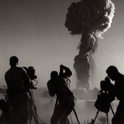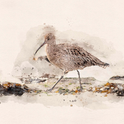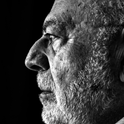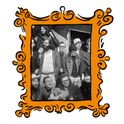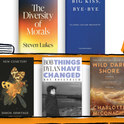Left, Ingres’s Study for La Grande Odalisque at the Courtauld Gallery. Right, Kandinsky’s Circles in a Circle at the Barbican
Leonardo da Vinci: Anatomist Queen’s Gallery, Buckingham Palace, until 7th October
Mantegna to Matisse: Master Drawings from the Courtauld Gallery Somerset House, until 9th September
Bauhaus: Art as Life Barbican Art Gallery, until 12th August
Yoko Ono: To the Light Serpentine Gallery, until 9th September
Boats and more boats, the lycra’d body beautiful, sport and more sport: what lurks behind the Jubilee and Olympics in London to challenge the eye and tax the intellect? Three extraordinary exhibitions, each extraordinary for parallel reasons. Each leads us more deeply into the heart of a teeming globe than any royal flotilla or running race could. A fourth show, by a woman whom the late 1960s made globally celebrated for reasons that had nothing to do with visual art, is like a Dalí-esque moustache-curlicue on the face of much seriousness.
Exhibition of the year is “Leonardo da Vinci: Anatomist” at the Queen’s Gallery. This is a unique display of Leonardo’s explorations, mainly in ink, of the insides of the human body. In his painting, his physiognomies and gestures reveal something about yearning, desire and aspiration, as well as about material status. His figures, not least of all in the great Milan Last Supper of the late 1490s—and of course that über-famous donna in the Louvre—are decisively post-medieval, striking poses towards modernity with imposing grace.
During the two phases of his anatomical investigations, the mid-1480s and mid-to-late 1510s, Leonardo wanted to examine the skull beneath the skin. Nowhere is this more graphically depicted than in an iconic image (which is featured on posters advertising the show) of a skull sectioned (1489). It is not only skeletally correct, but structurally precise: as satisfying to look at as an apple by Cézanne. More startling in an exhibition thick with revelation is a drawing the sculptor Henry Moore claimed was the most beautiful work he knew: a study of the human vulva, which, though anatomically rather rigid, possesses a daring and determination to set down new truths about us—the essential structures of life—which characterise every single one of these 87 sheets.
The show is about much more than biology. Each study here is a master drawing. You can linger for long minutes over an astonishing 1508 mapping of the cardiovascular system or stand before an exquisite, and exquisitely accurate, depiction of the human spine (1510-11), the first in history, and wonder pleasurably how a mind like Leonardo’s, along with his eyes and fingers, to say nothing of his skill at dissection, could have happened. He tracked just about everything that goes on inside us short of locating the soul—but never quite got how blood circulates.
Two small Leonardo pen-and-ink sketches for a painting of Mary Magdalene turn up in another revelatory summer show, at Somerset House. Leonardo’s anatomical pages belong to the crown. Like them, the drawings displayed in “Mantegna to Matisse: Master Drawings from the Courtauld Gallery” constitute a remarkable and infrequently displayed art collection of which the nation can be proud. Leonardo’s contemporary Michelangelo was one of the first artists to create drawings independently of finished canvases and frescoes, and here then is the prize of the Courtauld’s collection: his allegorical The Dream in black chalk, of 1533. It bursts with the vigour and fullness of a painting.
Mostly, drawings were stages to a bigger picture: tests for composition and perspective. For this reason Breugel the Elder’s richly detailed ink study of a village festival, Kermesse at Hoboken (1559), is a fascinating insight into how he planned his great panoplies of peasant life. Equally absorbing is Ingres’s sensual graphite anatomical study for his dazzling Grande Odalisque of 1814 (pictured above), hung in the Louvre; the dazzle is already present in the pencil lines. Each of these 60 works invites inspection of the scaffolding for some of the most gorgeous images in western art.
Closer to the present day, and a little further to the capital’s east, the Barbican Gallery has mounted one of the most comprehensive surveys ever of the Bauhaus. To some the word might be a little arid: wasn’t this a bunch of interwar Germans being programmatic about furniture and building? Certainly the school’s founders and leaders—Walter Gropius, Hannes Meyer, Mies van der Rohe—were serious about how to rethink the spaces in which we live. They were radical architects and designers. But what this utterly absorbing exhibition also conveys (allow at least two hours) is their playfulness and exuberance.
The movement, based until 1933 in Weimar, Dessau and Berlin, sucked in photographers and painters. Works such as Moholy-Nagy’s Construction in Enamel 1, Kandinsky’s Circles in a Circle (p70) and Klee’s Comedy, all from the early 1920s, show just how joyful their visualisations were, how free they felt. As sidebar information and many photos show, the Bauhaus partied as hard as they worked, but their objective was socially altruistic: they sought a new design for life. It was left to the “chicken farmers”—as doctor-director Jonathan Miller has described the Nazis—to break up the Bauhaus for good, as they broke up and ruined every single piece and act of pioneering culture in Germany for a generation.
Whether or not she broke up the Beatles—along, in 1969, with her third husband, who also badly wanted to leave—Yoko Ono has never quite understood her role in the band’s history. She tends to consider her “art” more consequential than their music. The late, great Beatles chronicler, Ian MacDonald, nailed the conundrum when he claimed that Ono’s intellect was superior to John Lennon’s, but his artistry superior to hers. “To the Light” at the Serpentine Gallery, featuring Ono films and installations from over four decades, is a delightful summer curiosity but might also confirm that MacDonald was, definitively, right.
Leonardo da Vinci: Anatomist Queen’s Gallery, Buckingham Palace, until 7th October
Mantegna to Matisse: Master Drawings from the Courtauld Gallery Somerset House, until 9th September
Bauhaus: Art as Life Barbican Art Gallery, until 12th August
Yoko Ono: To the Light Serpentine Gallery, until 9th September
Boats and more boats, the lycra’d body beautiful, sport and more sport: what lurks behind the Jubilee and Olympics in London to challenge the eye and tax the intellect? Three extraordinary exhibitions, each extraordinary for parallel reasons. Each leads us more deeply into the heart of a teeming globe than any royal flotilla or running race could. A fourth show, by a woman whom the late 1960s made globally celebrated for reasons that had nothing to do with visual art, is like a Dalí-esque moustache-curlicue on the face of much seriousness.
Exhibition of the year is “Leonardo da Vinci: Anatomist” at the Queen’s Gallery. This is a unique display of Leonardo’s explorations, mainly in ink, of the insides of the human body. In his painting, his physiognomies and gestures reveal something about yearning, desire and aspiration, as well as about material status. His figures, not least of all in the great Milan Last Supper of the late 1490s—and of course that über-famous donna in the Louvre—are decisively post-medieval, striking poses towards modernity with imposing grace.
During the two phases of his anatomical investigations, the mid-1480s and mid-to-late 1510s, Leonardo wanted to examine the skull beneath the skin. Nowhere is this more graphically depicted than in an iconic image (which is featured on posters advertising the show) of a skull sectioned (1489). It is not only skeletally correct, but structurally precise: as satisfying to look at as an apple by Cézanne. More startling in an exhibition thick with revelation is a drawing the sculptor Henry Moore claimed was the most beautiful work he knew: a study of the human vulva, which, though anatomically rather rigid, possesses a daring and determination to set down new truths about us—the essential structures of life—which characterise every single one of these 87 sheets.
The show is about much more than biology. Each study here is a master drawing. You can linger for long minutes over an astonishing 1508 mapping of the cardiovascular system or stand before an exquisite, and exquisitely accurate, depiction of the human spine (1510-11), the first in history, and wonder pleasurably how a mind like Leonardo’s, along with his eyes and fingers, to say nothing of his skill at dissection, could have happened. He tracked just about everything that goes on inside us short of locating the soul—but never quite got how blood circulates.
Two small Leonardo pen-and-ink sketches for a painting of Mary Magdalene turn up in another revelatory summer show, at Somerset House. Leonardo’s anatomical pages belong to the crown. Like them, the drawings displayed in “Mantegna to Matisse: Master Drawings from the Courtauld Gallery” constitute a remarkable and infrequently displayed art collection of which the nation can be proud. Leonardo’s contemporary Michelangelo was one of the first artists to create drawings independently of finished canvases and frescoes, and here then is the prize of the Courtauld’s collection: his allegorical The Dream in black chalk, of 1533. It bursts with the vigour and fullness of a painting.
Mostly, drawings were stages to a bigger picture: tests for composition and perspective. For this reason Breugel the Elder’s richly detailed ink study of a village festival, Kermesse at Hoboken (1559), is a fascinating insight into how he planned his great panoplies of peasant life. Equally absorbing is Ingres’s sensual graphite anatomical study for his dazzling Grande Odalisque of 1814 (pictured above), hung in the Louvre; the dazzle is already present in the pencil lines. Each of these 60 works invites inspection of the scaffolding for some of the most gorgeous images in western art.
Closer to the present day, and a little further to the capital’s east, the Barbican Gallery has mounted one of the most comprehensive surveys ever of the Bauhaus. To some the word might be a little arid: wasn’t this a bunch of interwar Germans being programmatic about furniture and building? Certainly the school’s founders and leaders—Walter Gropius, Hannes Meyer, Mies van der Rohe—were serious about how to rethink the spaces in which we live. They were radical architects and designers. But what this utterly absorbing exhibition also conveys (allow at least two hours) is their playfulness and exuberance.
The movement, based until 1933 in Weimar, Dessau and Berlin, sucked in photographers and painters. Works such as Moholy-Nagy’s Construction in Enamel 1, Kandinsky’s Circles in a Circle (p70) and Klee’s Comedy, all from the early 1920s, show just how joyful their visualisations were, how free they felt. As sidebar information and many photos show, the Bauhaus partied as hard as they worked, but their objective was socially altruistic: they sought a new design for life. It was left to the “chicken farmers”—as doctor-director Jonathan Miller has described the Nazis—to break up the Bauhaus for good, as they broke up and ruined every single piece and act of pioneering culture in Germany for a generation.
Whether or not she broke up the Beatles—along, in 1969, with her third husband, who also badly wanted to leave—Yoko Ono has never quite understood her role in the band’s history. She tends to consider her “art” more consequential than their music. The late, great Beatles chronicler, Ian MacDonald, nailed the conundrum when he claimed that Ono’s intellect was superior to John Lennon’s, but his artistry superior to hers. “To the Light” at the Serpentine Gallery, featuring Ono films and installations from over four decades, is a delightful summer curiosity but might also confirm that MacDonald was, definitively, right.

